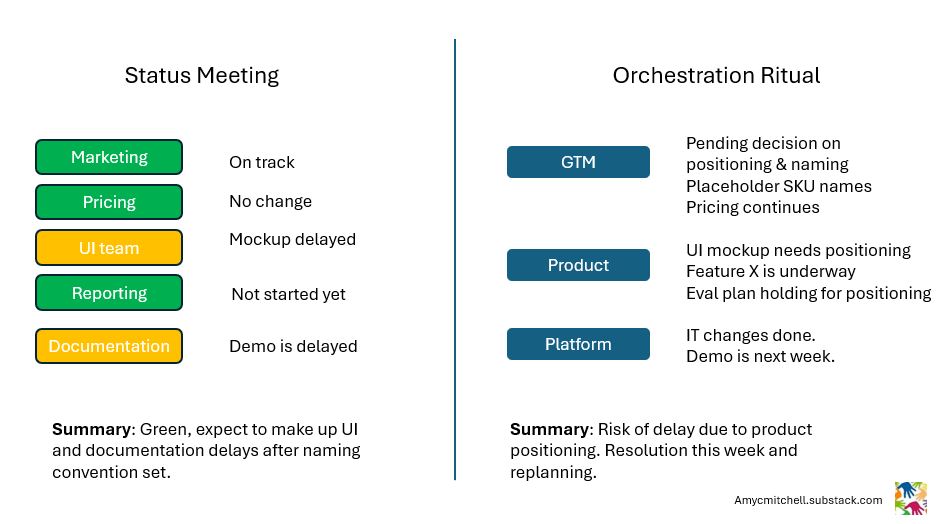The Orchestration Challenge for Product Managers
Turning strategy into delivery without losing focus on what matters
Your PRD is done. It’s sharp, clear, and backed by AI speed. You walk into kickoff expecting to discuss strategy, customer outcomes, maybe even the business case.
Instead, the first question is: “Where are the Jira stories?”
The program manager is focused on dates. No one’s talking about dependencies.
You realize: the risk isn’t in the PRD—it’s in the handoffs. And suddenly, your role stretches from product manager to orchestrator.
This is the hidden work that connects strategy to delivery. Building your orchestration muscles is how you prevent gaps, earn leadership trust, and deliver customer value.
Why are product managers getting pulled in more? It isn’t because program managers are less capable—it’s because the environment has changed.
Why Now?
Organizations are flatter. Teams self-organize. AI takes the grind out of tasks like writing PRDs. Delivery moves faster than ever—yet complexity hasn’t gone away.
Products are made of components, integrations, and customer-facing touchpoints that don’t coordinate themselves. Someone has to hold the threads together. Increasingly, that someone is the product manager.
Orchestration isn’t busywork—it’s the missing bridge from requirements to outcomes.
3 Orchestration Skills for Product Managers
1. Map Dependencies That Matter
Your first orchestration muscle is visibility: showing the seams that others can’t see. Each team is racing ahead, confident in their piece of the puzzle. But no one’s watching the seams. That’s where things break.
Your job isn’t to micromanage—it’s to highlight touchpoints that matter. Think of dependencies as anything a customer will notice: demos, UI changes, pricing, SKUs, evals.
The best way to track them? Build an initiative roadmap (different from your usual stakeholder roadmap).
An initiative roadmap shows:
Major dependencies like SKUs, pricing, evaluations
Customer-visible touchpoints (mockups, demos, UI changes)
Key checkpoints for readiness and risk
This roadmap becomes your north star for delivery. It’s not a glossy artifact—it’s a working tool that makes hidden dependencies visible across teams.
2. Build Lightweight Orchestration Rituals
Expert teams want to run fast—but without shared rhythms, dependencies fall through the cracks. The solution isn’t heavy process. It’s lightweight rituals tied to your roadmap.
Typical milestones worth syncing on:
Mockups & demos → alignment on intent
Eval plans & dry runs → catching risks early
Final evals → readiness check for real-world use
The ritual itself can take many forms:
Updating the initiative roadmap to reflect progress
A Jira board view focused on dependencies, not just stories
A quick weekly sync across teams
The frequency depends on release cadence. Fast-release products lean on automation. Longer cycles may need a weekly or biweekly meeting.
The point isn’t the ritual—it’s the communication. Dependencies stay visible. Progress is shared. Leadership gets natural updates.
What you’re building isn’t a meeting. It’s a rhythm. A rhythm that keeps delivery connected to strategy.
3. Make Risks Visible Early
The biggest risks hide in the spaces between teams. If you surface them early, they’re cheap to fix. If you don’t, they explode late.
Think of risk visibility as a radar scan. You’re not predicting every issue—you’re spotting the ones that matter before they surprise the customer.
A way to think about orchestration risk is with a 2x2 risk radar
Horizontal axis: When the risk shows up (early vs late in the initiative)
Vertical axis: How easy the risk is to fix (within a team vs between teams)
Some common orchestration risks are:
Pricing too high or too low
Naming mismatch: differences in product, documentation, and marketing content
SKU and UI disconnect: SKUs, features, and UI differences in action
Ordering trouble: a segment of customers struggles to order the right thing
Feature overlap: features over time don't seem related to each other
Most orchestration value comes from catching the issue early. That's where the roadmap and rituals help the most.
Think of the radar as your early warning system. It helps you shift from firefighting at launch to guiding the system early.
Conclusion: Build Your Orchestration Muscles
AI accelerates product work. Teams ship faster. But orchestration is still human—and it’s becoming one of the most valuable skills a product manager can bring.
By connecting strategy to delivery through roadmaps, rituals, and risk visibility, you won’t just reduce product risk—you’ll prove you can get complex initiatives across the line.
And that reputation—the PM who can orchestrate complexity—is exactly what every leadership team is looking for.
Related Links from Product Management IRL
Evals for Product Managers: Getting started with evals to help in orchestration
Structuring requirements for Tracking: Setting up your requirements so orchestration is low effort
Requirements Checks Before Release: Setting up requirements to summarize the status to stakeholders
Looking for more practical tips to improve your product management skills?
Become a paid subscriber and get more weekly tips. Last week’s article: Handling Tricky Monetization Questions
Premium Product Manager Resources (paid only) 3 learning paths, 6 product management templates and 7 quick starts. New items monthly!
TLDR Product listed Product Management IRL articles recently! This biweekly email provides a consolidated list of recent product management articles.
Connect with Amy on LinkedIn, Threads, Instagram, and Bluesky for product management insights daily.








